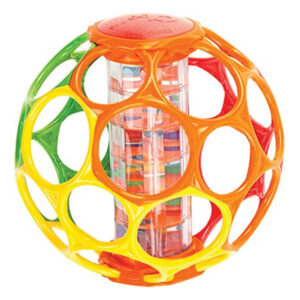Social interaction skills
A young infant participates in responsive interactions with a caregiver using a novel ball.



Be Prepared: Secure a ball with interesting features that an infant can easily grasp, such as the Oball Rollin Rainstick Rattle.
 [Place the infant on his/her back in a comfortable reclining position.
[Place the infant on his/her back in a comfortable reclining position.
Smile and begin talking with the infant. Example: “Good morning, Mason! I am happy you are here today. You look ready to play!” Acknowledge the infant’s reactions, including any vocalizations and/or facial expressions. Examples: “You are smiling, Aria! I smiled at you, and you are smiling at me!”
Hold the ball about 12 inches from the infant, at his/her midline.]
Look, I have a ball for us to play with! Listen to the sound our ball makes. Maybe you would like to touch and hold the ball.
[Gently shake and move the ball slowly from side to side to attract the infant’s attention. Watch for the infant to respond by gazing, batting at, or reaching for the ball.
Describe the infant’s reaction to the toy. Examples: “Your eyes got wide when you saw our toy. You are looking at the ball.” “You kicked your feet when you heard the rattle inside the ball, Muhammad! I think you like our ball.”
Move the ball close to the infant so he/she can touch or grasp it. Describe your action. Example: “I will hold the ball close, so you can touch it.” Describe the infant’s actions. Example: “You reached for the ball as soon as you saw it, Lily! I moved it closer. Now you are holding it.”
Watch for and acknowledge vocalizations and/or facial expressions.]
[Offer a brief description of the interaction. Example: “We had fun with a ball, Mason. You moved the ball and listened to the sound it made!”]
Social interaction skills
An older infant participates in back-and-forth interactions with a caregiver while playing with a ball and a basket.



Invite an infant to sit with you on the floor to play with a ball. Place the basket between you. Name the basket for the infant. Introduce the ball, and invite the infant to hold and explore the ball. After several moments, encourage the infant to drop the ball into the basket. Enthusiastically acknowledge the infant’s actions. Example: “Nicholas, you put the ball in the basket! Look, the ball is in the basket. Yay, Nicholas!”
Remove the ball from the basket. Describe your actions and their results. Example: “I took the ball out of the basket. Look, the basket is empty!” Gently place the ball in the basket and describe your action. Invite the infant to take the ball out of the basket. Then explain that it is the infant’s turn to put the ball back in the basket. Demonstrate putting the ball in the basket if it appears the infant is not clear about your suggestion.
Promote a back-and-forth pattern with the ball with the following strategies:
Pause for the infant to start or contribute to the exchange. Maintain eye contact. Remember to use facial expressions to communicate with the infant. Focus on the interaction with the infant more than getting the ball into the basket.
Both options use an object(s) to facilitate interactions between you and an infant. Look for ways to demonstrate your responsiveness to the infant’s actions and attention to you. In Option 1, the young infant will benefit from your gentle comments about how he/she is playing with the novel ball, and some freedom to explore the ball as he/she wishes. In Option 2, your careful guidance is needed for an older infant to experience a back-and-forth exchange with the ball and basket. Be prepared for the infant to be interested in doing one action only, such as placing the ball in the basket, but not retrieving the ball from the basket, and perhaps only one round of handling the ball. The length of each activity is likely to range considerably across infants and situations. In Option 2, an infant may be interested in carrying the ball around the room and not dropping it in a basket. At this young age, children cannot be expected to understand the concept of taking turns, but Option 2 has potential to support the development of early awareness of how back-and-forth exchanges can work. Your being tuned into the infant is central to the success of each option.
Extra support
Enrichment
Materials Needed: assortment of balls in different sizes, textures, and colors, several containers to fit one or two balls (such as a bucket, basket, or large bowl)
Provide opportunities for infants to play with balls and containers. Infants may enjoy exploring the balls individually, or practicing filling and dumping the containers. Infants may enjoy watching their peers engage in the materials in similar ways. Describe infants’ actions with the balls. Recognize facial expressions and repeat and extend infants’ vocalizations.
Materials Needed: medium-size soft ball
Invite older children to play a game of passing the ball to a named peer. Encourage children to sit in a loose circle and pass the ball to the child you name. The children may hand the ball to the peer or roll the ball across the circle. Invite children to repeat the name of the child holding the ball. Ensure that each child has a turn to hold the ball and hear his/her name spoken. Babies may enjoy holding an age-appropriate ball and hearing their name spoken during the activity.